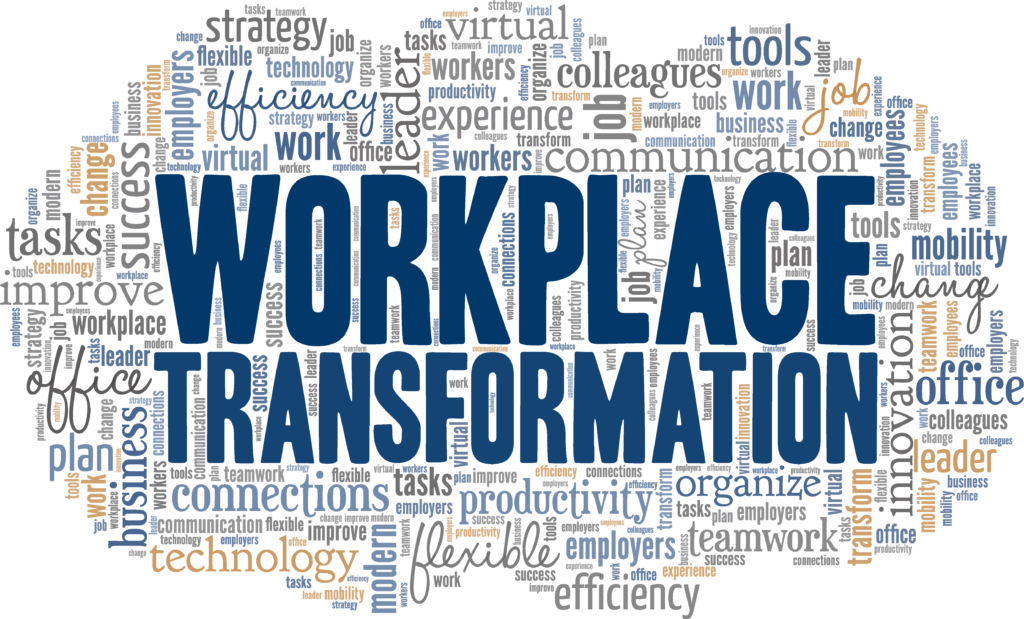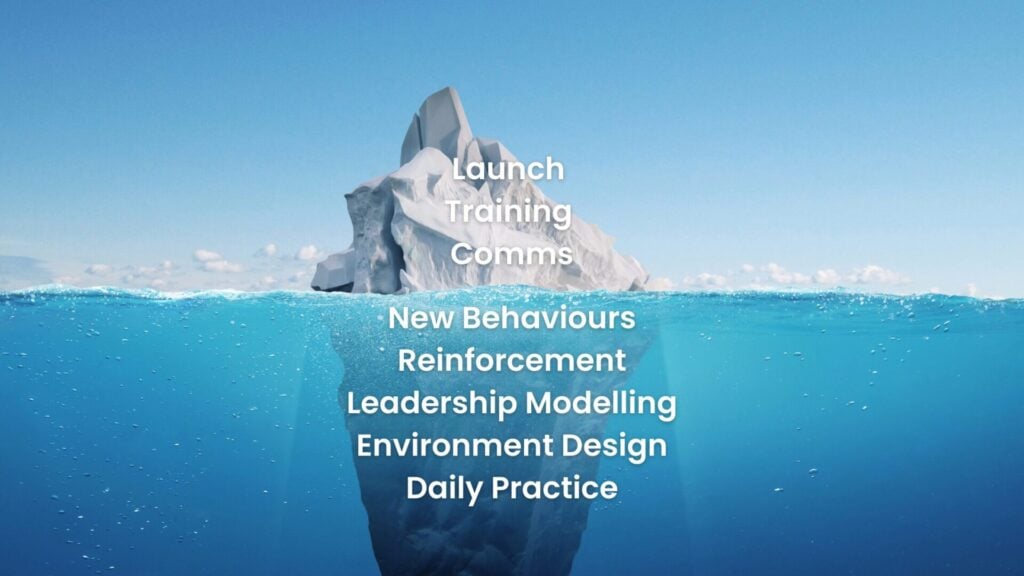Managing Change in the Workplace
By Applied Change
Share

Why is workplace change so important to get right?
Most organisations and most sectors are faced with a continual need to adapt to keep up with continual changes in customer demands, changes in the market, and other macro-economic factors. Whether simply responding to outside factors or driving change from within, organisations need to be nimble and ready to implement change promptly and effectively when required. Without the willingness and ability to change quickly, an organisation will stagnate and may well struggle for survival in today’s competitive markets.
With change an essential part of every business, it’s ever more critical that we focus on managing change successfully. A startlingly high number of change initiatives are unsuccessful, with the odds firmly in favour of failure. Back in 2008, a study by IBM showed that only 41% of projects met their objectives, and subsequent research shows no improvement. A more recent study in 2019 shows that if we combine the usual measures of a job well done (on-time, on budget and benefits realised) then the percentage drops to an alarming 0.5% success rate.
As the saying goes, if we do what we’ve always done then we’ll get what we’ve always got. The good news though is if we are prepared to focus on what’s behind these numbers and do things a little differently, there’s a huge opportunity, often in the £ millions for many change initiatives.
So where do we start? With the people involved in the change.
The role of employees and stakeholders in organisational change
Employees and stakeholders play a crucial role in the delivery of organisational change. Success relies on employees buying into the vision for change, so that they are motivated to support the programme in whatever way is needed.
We find it can be useful to consider two main categories of employees who are affected by change:
- Those who are directly involved in delivering the change, and
- Those who are not directly involved in making the change happen but are impacted by it
Considering how we tend to respond to change and how most of us don’t like being “done to” it’s well worth considering how we can encourage as many people as possible to feel like they are in the first group. Most of us prefer to feel we are masters of our own destiny, so involvement empowers us and helps to foster enthusiasm for the outcome. For those we can’t involve directly, it’s important to help them remain comfortable and aware of what the change will mean to them, ideally through regular 2-way communication, keeping them informed of plans and progress, whilst also acknowledging any concerns and being there to support them where needed.
If employees or stakeholders are failing to support the implementation of change, this will quickly put the brakes on progress, so we need to find ways to identify and then tackle any resistance before it spreads. The attitude of one person can quickly permeate entire teams or departments.
Employees at the front line are often well placed to give honest and insightful feedback on proposed changes and how they are being implemented, so we should not miss that opportunity.
How can we better support employees through change?
At the very least, we need to help them to feel motivated to make it happen and feel comfortable about what it means to them. We’ll cover more on that later but here are a few ideas to start with:
- Communicate a clear and compelling vision for the outcome. It is much easier to accept a period of uncertainty and instability when we believe that the end result will be better than what we have today. And we each have different preferences when it comes to communication, so the way we communicate needs to be considered too, ideally using a range of different channels to suit the preferences of different employees.
- Explain why the change needs to take place, from the perspective of those we are trying to engage. When employees understand the reason for change, they are less likely to resist it. It’s also worth keeping in mind though that emotions and self interest can also play a part in undermining a rational case for change.
- Share details of the timescales involved and be open about the challenges that can be expected in delivering the change. When people know exactly what to expect, it’s easier for them to be comfortable with it.
- Remind employees of any past change initiatives which have had a positive outcome for them. This can help people overcome apprehension about change. It can also serve as a reminder that although the change process itself may be challenging, the end results will bring benefits that make it worthwhile.
- Break the change down into manageable phases with intermediate goals, so that successes can be achieved and celebrated during the overall programme. This is a simple way to maintain momentum and morale, particularly in a lengthy and complex change initiative.
- Acknowledge the emotions that change can generate for people. Fear is a natural response for some, while others may be energised by change. We know from the Kubler-Ross Change Curve, adapted from the 5 stages of grief, that people will pass through a series of phases when faced with change – Shock, Denial, Frustration, Depression, Experiment, Decision, Integration
A simple framework for change – 5 key elements
What are the key elements that lead to successful change outcomes?
We’ve reflected on this from our own extensive experience in a wide range of sectors and situations and from the huge body of research into change and human behaviour. We’ve found that focusing on just five key elements can have a huge impact on the likelihood of a successful outcome, regardless of the nature of the change involved. These are universal and widely applicable, whether it’s personal change, change at work or at a global scale. Try them for yourself on a change you are involved in or working on and see if you can identify any that are missing.
Let’s take a look at each of the 5 elements in turn.
- Energise – Ensuring sufficient motivation or desire for change. This is something that is personal to each of us so when we are making the case for change, it’s worth considering how we can make it feel compelling enough to overcome the easy and safe option of staying as we are.
- Enable – Understanding and dealing with the barriers or obstacles slowing the change down. For even the simplest of changes there are things that could make us pause or resist. In a work context, fear of losing out in some way, fear of the unknown, lack of time, are all common examples. Taking the time to consider and mitigate any areas of friction can help to ensure the change moves through more smoothly.
- Execute – Making the change journey feel more achievable. While we may feel that we like the idea of the change, it may feel overwhelming or impossible to achieve. Helping those involved to understand the journey and to see progress, ideally as early as possible, can have a strong impact on our feeling of achievability.
- Embed – Ensuring that we sustain the changes after we’ve made them. A common complaint with organisational changes is the tendency to slip back into old ways of working. Habits are strong so it’s worth considering how to reinforce the new behaviours and discourage the old until they have properly bedded in and become the new normal. Leading by example is critical to this.
- Evaluate – Learning and adapting the approach based on what’s really happening. Situations change, often very quickly, so we need to stay aware and be ready to adjust course if needed. That may be in the way we are delivering the change or even the nature of the change itself.
We’ve found that focusing on just these five elements can have a huge impact on the likelihood of success for any change. These elements are drawn from a range of theories and best practices from the field of change management, including Lewin’s 3 Stage Model, Kotter’s 8 Steps, the Kubler-Ross Change Curve, and Nudge Theory. The 5E model can be explored further here [https://appliedchange.co.uk/our-model/5-elements-summary/]
Applying the 5 elements to a change in the workplace
The simplest starting point is to assess the readiness for change of the people involved against these five elements. A simple and effective way to do this is to make use of a change readiness assessment tool specifically designed for a team or large group.
Using a change readiness tool alongside other change management activities can help leaders to continually monitor the “mood in the room” as the change progresses. Ideally beginning at the start of the change, it then makes sense to check regularly (every 3 to 6 months) by running the assessment again.
This then helps to take a measured approach to how people are feeling throughout the change process. It highlights what’s working well and where focus is needed. It’s therefore a way of guiding the change management activities based on what’s really happening and, more crucially based on what the people involved are feeling about the change.
Of course, this is just the start and whilst it helps to focus attention, it’s also important to augment with good conversations via one to ones or focus groups.
Wherever there is a change, there are people involved and everyone will have an opinion, whether it’s voiced or not. We each make our own choice about how and when we’ll get involved, especially when confronted with a change at work. And it’s that choice that defines how well the change will go.
Get in touch
If you’re not achieving your goals or want get more done in your business, we can help.
Whether it’s supporting you, growing your leadership team or directly helping you to make something happen, contact us on (+44) 0800 612 3548 or click the button below.
Alternatively sign up below to be the first to know about our events and receive free resources and insider tips.
Related content
Embedding Change: Why Habits Matter More Than Announcements
Most change efforts fail not because of poor planning, but because old habits resurface after launch. Discover why behaviour change is the key to lasting transformation — and how to embed new habits that actually stick.
External help – how to choose
From time to time we all need external help to get things done but getting the right kind of help can be a confusing process. There are so many options and each situation is unique. This guide is intended to help you navigate the various types of external support to find the one best suited for you and your situation.
Satya Nadella – Hit Refresh
Think that some organisations are too big or too well established to change? Think again. Satya Nadella and the team at Microsoft of proven otherwise.





